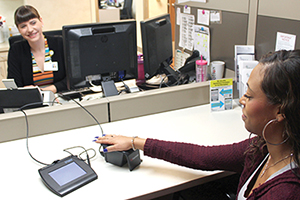By TIM O'NEIL
At Mercy Medical Center in Sioux City, Iowa, the palm reader is always right. No need for confirmation with tarot cards or crystal ball.

The procedure is a simple scan of a patient's palm, which has a unique pattern of veins. The infrared scan reader, a device about the size of a coffee cup, links the palm print to the hospital's files for an exact match in patient records.
It can eliminate the risk of mixing up the John R. Smiths, both age 66. And admitting a patient whose palm print already is in the hospital database is a faster and surer process, requiring little or no paperwork.
Those are the principles behind Mercy Medical Center's introduction of palm readers for its patients last fall, when Trinity Health of Livonia, Mich., installed them in 26 of its 93 hospitals. The health system hopes to have the biometric devices in all of its hospitals by next summer.
Biometrics, the detection of unique physical traits to confirm identity, is not new. Police agencies have reliably used fingerprints for a century. Newer forms include iris scans and voice recognition.
Kaitlyn Mohrhauser, clinical applications analyst with Trinity Health, said the devices are simple to use and require less than an hour of training time for staff members. Mohrhauser said its use adds only a few moments to admitting a patient for the first time, and the scan data is available for any subsequent admission or transfer.
The hospital still requires standard identification, such as a driver's license, Social Security number and date of birth for a first admission. But with about three-fourths of the hospital's 700 or so daily patients having been there before, the palm reading achieves the hospital's objectives of accuracy and speed during subsequent admissions, she said.
"There is always the chance for human error even when we take all the proper steps," said Mohrhauser, who supervises a staff of 30 in patient registration. "The benefit is that we can follow through the proper patient identification every time."
An especially useful example, she said, is with the arrival to the emergency department of an unconscious patient who has no identification. If the patient has been there before, the staff can verify his or her identity with a palm scan.
Mercy Medical Center is using PatientSecure, a palm-scanning device sold by Imprivata, a health care security company in Lexington, Mass. Imprivata says more than 350 hospitals use the device, including Bon Secours St. Francis Health System of Greenville, S.C. Kerry Pillion, a spokesman for Imprivata, said client hospitals have enrolled about 9 million patients in their palm-print databases.
Imprivata's website includes a video where a St. Francis technology executive extolls the time and cost saving benefits of the palm scanning identification.
Becky Carter, St. Francis administrative director of informatics and health information management, said it was costing the health system about $500,000 in staff time for employees to correct misidentified patient records. Commonly, insurance companies reject claims because of record errors. PatientSecure reduced such errors and lowered costs of processing claims, Carter said.
After researching the market, Trinity Health began testing PatientSecure in March 2016 at its Mercy Health hospital in Muskegon, Mich. Cynthia D. Fry, senior vice president and chief revenue officer for Trinity Health in Livonia, described the test as "the most seamless technology deployment I have been a part of." She said patients found the technology "gave them an extra level of confidence" during admissions.
Fry said palm scans also can prevent patient identity theft.
Timothy J. MacDonald, Trinity Health's director of transformation deployment, said Trinity Health considered and rejected other biometric systems. Fingerprints can be marred by hand injuries and aging, and some patients resist fingerprinting because of its use in law enforcement. He said some patients find eye-scanning uncomfortable.
MacDonald said Mercy Health Muskegon introduced the palm scanner with a public-information campaign that included demonstrations at a shopping mall. There, he said, 150 people volunteered to be scanned for future identity confirmation at the hospital.
"We reached out to the community and found widespread acceptance," he said.
That also was the reception at Mercy Medical Center in Sioux City, said Mohrhauser, who was concerned there might be some resistance to the technology. Mercy Medical Center also had a public-information campaign before it introduced the devices on Oct. 24.
"We have found that patients are more comfortable once we explain it," she said. "They like that we are doing something to ensure the integrity of their information."
